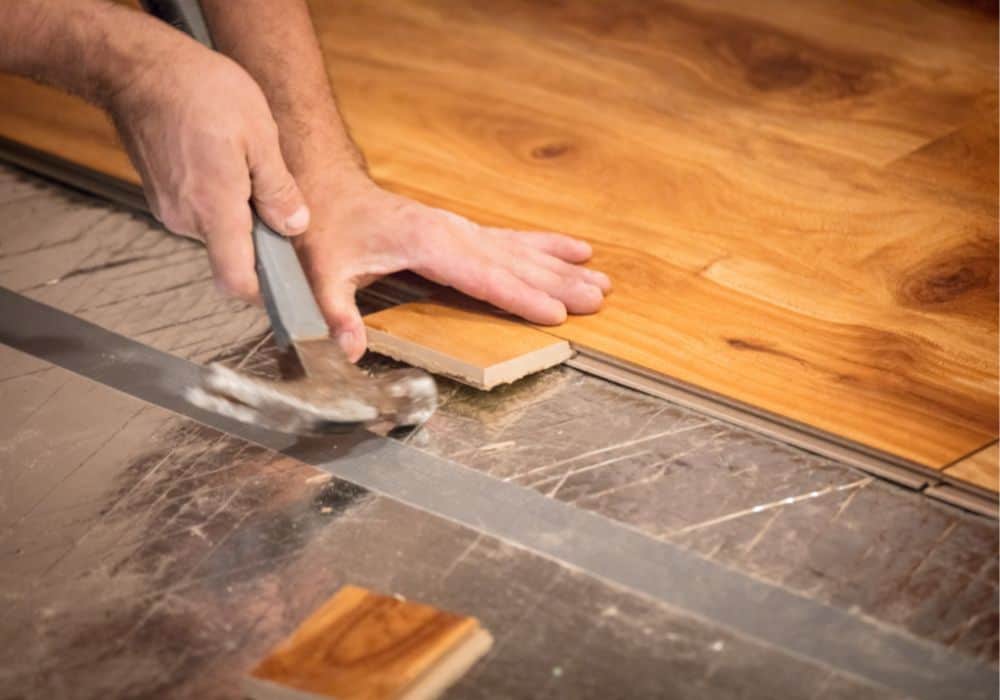Picture this: You’re finally settled into your new home, and you’re excited to make it your own. The kitchen, though, feels bland and dated with its old tile floor. You dream of a warm and inviting wood floor, but the thought of ripping out the existing tile makes you cringe. It seems like a major undertaking, doesn’t it?

Image: housegrail.com
Well, you are not alone. Many homeowners grapple with this exact dilemma. Can you transform your tile floor into stunning wood flooring without the hassle of complete demolition? The answer, thankfully, is often a resounding yes! This article delves into the fascinating world of laying wood flooring over tile, exploring the nuances, challenges, and rewarding possibilities it presents.
Understanding the Feasibility
The prospect of installing wood flooring over tile might sound like a shortcut, but it’s essential to approach it with a realistic understanding. The success of this endeavor hinges on various factors, including:
- The Condition of the Existing Tile: Cracks, unevenness, or loose tiles can create a surface unsuitable for wood flooring.
- The Type of Tile: Ceramic and porcelain tiles are typically more stable and suitable than softer tiles like vinyl.
- The Subfloor: It needs to be sturdy and flat to support the added weight and movement of the wood flooring.
- The Type of Wood Flooring: Engineered wood flooring is generally more forgiving than solid wood, making it a preferred option.
Exploring the Advantages
Before diving into the specifics, let’s take a moment to appreciate the advantages of laying wood flooring over tile.
- Cost Savings: It can be significantly more cost-effective than removing the tile entirely.
- Time Efficiency: It can potentially save time compared to a full demolition and installation process.
- Less Mess: You can minimize dust and debris by avoiding a complete removal of the existing floor.
- Aesthetic Appeal: Transform your space with the charm and warmth of real wood flooring, bringing a fresh and modern look.
Preparing for the Challenge
Laying wood flooring over tile is a project that demands meticulous preparation. Here’s a step-by-step guide to ensure success:
- Assess the Tile: Conduct a thorough inspection of the tile floor for loose tiles, cracks, unevenness, or any other imperfections that might interfere with the new flooring.
- Check the Subfloor: Confirm that the subfloor is solid, flat, and structurally sound. You can use a level to check for any unevenness. Remember that a subfloor should not deflect more than 1/8 inch over a 10-foot span.
- Consider the Existing Adhesive: The type of adhesive used to lay the tile will influence the process. Some adhesives are difficult to remove, requiring special techniques.
- Prepare the Surface: If necessary, you might need to level uneven tiles with a self-leveling compound or use a tile bonding agent to create a smooth and even surface for the new flooring.
- Moisture Barrier: Ensure your subfloor is properly protected from moisture by installing a moisture barrier if not already present. It is crucial to prevent the wood flooring from warping or deteriorating due to moisture penetration.

Image: www.whatisvinyl.com
Choosing the Right Flooring
The type of wood flooring you choose is crucial for a successful installation over existing tile.
- Engineered Wood Flooring: It is engineered to be more stable and less susceptible to moisture issues, making it a popular choice for installation over tile. Its multi-layer construction allows for greater flexibility in handling unevenness and moisture.
- Consider Thickness: A thicker engineered wood floor provides greater stability and better resistance to movement. Aim for a minimum thickness of 3/4 inch for optimal performance.
- Click-Lock or Glue-Down: Click-lock installations offer a faster and easier installation, while glue-down can be preferred for increased stability in difficult situations, but it requires a more detailed application.
Installation Techniques: A Detailed Guide
Once you’ve prepared the surface and chosen your wood flooring, the installation process is similar to traditional wood flooring installation, but with a few key differences:
- Underlayment: A specialized underlayment designed for over tile installations is essential. This underlayment helps to cushion the wood flooring and improve soundproofing.
- Adhesive: While some click-lock flooring can be installed over tile without additional adhesives, glue-down installations typically require a specialized adhesive. Ensure the adhesive is specifically designed for tile and wood flooring.
- Installation Methods: Click-lock flooring is often easier and quicker to install, requiring less expertise than traditional nail-down or glue-down methods.
Expert Advice and Final Considerations
Laying wood flooring over tile is a project that is best entrusted to professionals, especially if you are dealing with complex situations. It is always wise to consult with a qualified flooring expert for guidance and professional advice.
Here are a few critical factors to remember:
- Building Codes: Be sure to check with your local building codes before starting the project.
- Warranties: Consult the flooring manufacturer’s warranty to see if installing over tile is permitted and how it might affect the warranty’s terms.
- Maintenance: Wood flooring over tile requires specific maintenance considerations.
Can Wood Flooring Be Placed Over Tile
Conclusion
Laying wood flooring over tile can be a rewarding project that transforms your home’s aesthetic appeal. With careful consideration, preparation, and professional expertise, you can achieve a beautiful and durable flooring solution without the hassle of a complete demolition. Remember to weigh the advantages against potential challenges, consult with professionals, and follow proper installation techniques to ensure a successful transformation. Your dream of a warm, welcoming wood floor might be closer than you think!






